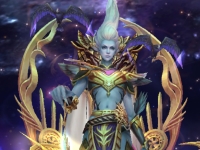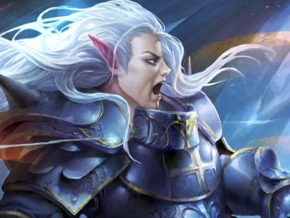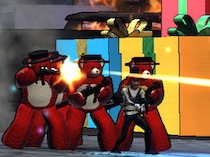Forsaken World: War, Carnage, and Turtles
By Jake Winters (Kibeth), OnRPG Journalist
Forsaken World is another in a long line of Asian-born MMOs claiming to combine eastern and western gameplay; the difference is that where many others have failed, Forsaken World has succeeded. The game mixes beautiful graphics with an innovating class, quest and job system, producing something spectacular. Released in March 2011 after nearly a year of beta testing, the game is finally living up to its promise of being one of the AAA titles of the F2P market.
The Story
The storyline is somewhat cliché, a generic god of creation (Dyos) and a generic god of destruction (Nyos) playing a sadistic game of chess, using pawns and demi-gods to battle across the cosmos. Ultimately, the battle settles on Eyrda, the world upon which Forsaken World takes place. The lore itself is lost in the games endless pages of quest text and ragged translations, and even those going so far as to seek it out may find the story so doggedly complex that it becomes uninteresting. That isn’t to say that the game and quests are dry. The game focuses on a single drawn-out war, detailing the paths of five difference races and their role in the fight against the fearsome Storm Legion, though this in itself seems underwhelmingly ‘small’ in a universe-wide conflict.
Character Creation
Depending on the race picked during character creation, players will find themselves at one of the numerous starting zones with its own sub-storyline, though all converge somewhat when players are introduced to Freedom Harbor, a large shared city and quest-hub. For those familiar with Perfect World Entertainment’s in-house games, this is the standard path.
“That sword’s only seven feet long? For shame.”
One of Forsaken World’s strengths is how customizable character creation can be. With five races and eight classes, players are spoilt for choice. While certain classes are locked to a race (for instance, only Dwarves can become Marksman), this is relatively uncommon. The races are Human, Elf, Dwarf, Stonemen, and Kindred. As a starting player you won’t notice much impact on your gameplay based on race except for physical appearance and a small number of (weak) racial abilities. Once you hit level 30 though the nuances become apparent in the mastery tree where each race carries unique passives and power ups to their skill sets for the same class. Speaking of the classes, you can choose from:
Assassin: high DPS melee fighters, incredibly evasive but low HP and defense
Bard: support characters using songs to empower teammates or addle enemies
Mage: high DPS and AoE characters, but incredibly weak if not kept at range
Marksman: high DPS, DoT-using range fighters with impressive speed but low HP
Priest: default healers, incredibly powerful support characters, lacking in solo play
Protector: high HP and high defense tanks, lower DPS and lacking magical aptitude
Vampire: high DPS and self-heals, but must use their own HP to do damage
Warrior: versatile melee fighters, jack of all trades character but master of none
Beyond this, character creation offers a huge range of skin tones, facial patterns (such as tattoos), hair styles, and a star sign. Forsaken World is one of the most customizable MMOs around.
Graphics and First Impressions
Gamers are given a cutscene-driven introduction to their race’s storyline, before being thrown head-first into the world. The most immediate observation is the graphics: flashy water effects, colorful characters, and a realistically busy environment make the game a work of art. Spell effects are vibrant, and the overall vividity of the game hides incredibly well the storyline of general death and carnage. Equally, the game is seamless, with few loading screens to interrupt the otherwise immersive gameplay.
Even with toned-down graphics the game looks exceptional.
With the faultless graphics accompany a less-than-faultless audio experience. While the game music is well-composed, players may find themselves reaching for their iTunes after hearing the same three minute loop for the hundredth time.
Combat Mode Engaged!
Each class is treated to a number of talent trees, and these are unlocked at level 20. The variety of trees effectively triples the number of classes available, as each tree remains relatively unique, especially as players invest more points into them.
Combat itself is simple, with a point-and-click or tab-target method to select the next hapless victim, followed by mashing whichever key lights up to turn their skulls into confetti. The game adds flair to combat by giving certain classes a different spins on their attacks, such as a Warrior’s stances making them able to switch from tank to dps at a moment’s notice, or a Marksman’s magical bullets empowering normal abilities. The bard, a favorite of classes (though cited as incredibly difficult to master) creates chords as he uses abilities, and these chords – if played in a certain order – will provide the group with short-term beneficial buffs. It is simple things such as this that set Forsaken World miles apart from the usual ‘health, mana, let’s go’ combat of games gone by. Perhaps if more MMOs invested in simple but interesting combat mechanisms, grinding and combat generally would be considered much less of a chore. Indeed, Forsaken World’s combat system is one of the better systems on the market of either F2P or P2P games; another piece of praise to add to the already swelling list.
Level Up!
After a number of hours of play, it soon becomes obvious that Forsaken World is a time-demanding game; attaining the maximum level (currently 80) requires months of regular play, and gear hunting beyond that is entirely another story.
The game itself offers the usual means of gaining experience such as completing story quests, daily quests, instanced dungeons, and a plethora of themed events (such as Christmas or Halloween). It also steps away from the Eastern-developed cliché of ‘grind-heavy’ gaming, with grinders being punished with a sickeningly low amount of experience for monster killing.
With so many quests available per day, grinding need not be an option. Hooray!
Instances themselves are generally small encounters where the player groups with a number of other to take down a powerful enemy. The game makes this process easier by offering an instance-finding tool, so that solo players are not punished for their solo nature. Among all of Forsaken World’s features, this is one of the most commendable ones, even if the idea itself is not a new one.
Instances are a great way to level and meet new people, if you survive their depths.
These instances are considered the highest means of gaining experience, however the game itself prevents players from entering too many times per day (the reasoning for this is beyond comprehension and surely offers no benefit to players wanting to level up). I was pretty sad about this because the instances are very well designed, with unique international themed locations and truly challenging boss battles. To make up for this seemingly evil oversight, Forsaken World players are treated to a number of daily quests, as well as a Revelation system which allows daily ‘prayers’ to be answered by the Gods, conferring upon the player a large amount of experience and other goodies such as experience-boosting scrolls.
Forsaken World has done well to avoid the typical monster grinding, or even more typical go-and-kill/go-and-fetch quests that dog less inspired games. Quests are made incredibly simple by the auto-route function, which allows players to select an NPC anywhere on the current map and have the game move them there automatically; indeed, the first thirty or so levels are easily playable by simply having the quest log open and doing this!
There is a moderate amount of content available through the leveling experience, though players nearing level 80 (and the months of play that accompany it) will undoubtedly find themselves bored of the same instances or daily quests, a boredom unsalvageable even by the plethora of additional events hosted by the game.
The Added Extras
Forsaken World continues to prove its uniqueness with additional game features. Players are introduced to over ten different jobs ranging from Alchemist to Fisherman to Weaponsmiths; and there is no limit to the number of jobs a player can have at a single time. Unfortunately, the game imposes restrictions on the number of times a player can gather or craft something (using a points system known as Energy for gathering, or Vigor for crafting), and these points recharge either when the player is online, or very slowly when the player is offline, effectively forcing players to play regularly in order to be able to engage in these activities. Unlike other games where players are rewarded for not playing (such as World of Warcraft’s temporary experience boost), it seems unfair that Forsaken World goes the other way and punishes players for not playing.
”I’m warning you, don’t teleport to town and log off, I’ll have to punish you!”
During the first few levels, players are given a permanent pet that follows them around and aids them in combat (and generally looking awesome; what’s not to like about a giant fiery horse following you around?). These pets grow with their owner, and offer an additional perspective on the already-fun combat system, with their own set of stats, skills, and AI. Pets are relatively low maintenance, able to heal themselves in combat, and requiring little out-of-combat attention.
Additionally, the game offers a typical range of titles and achievements, though these are nothing to write home about. More important is the number of niches of information that the game provides to those who look, such as books to be read and study quests resulting in a collection of short stories as a reward. For players bored of the game itself, this provides a little light relief and gives players the opportunity to slow down and enjoy the world around them.
Here’s a great feature for you: Elves that actually look masculine.
When players are tired of the big, bad world, it is little features like perfecting the job system or collecting all of the pets that keep them interested a little longer (perhaps long enough for that next big content patch, or until their burnout is over). Forsaken World does this perfectly, something many competitors (especially those of a grind-based nature) overlook.
Yet another way players can spend their time away from the grind is by helping their guild to gear up its customizable base. After guilds run enough guild quests, they can eventually bid on a flying guild base via an auction system. These bases allow you to choose which types of buildings to construct and upgrade, as well as offering unique guild positions such as ‘tax collector’ to build a type of community I’ve never come across in an MMO before. It’s interesting to have to visit a guild base and pay taxes to the local owner in order to craft weapons and armor not available by any other means.
All About The Money
Unfortunately, that’s where the praise ends. Like most F2P MMOs, Forsaken World’s need for cash is sated by an extensive (and expensive) Cash Shop. The shop offers a variety of unique pets, equipment, mounts, buff and experience scrolls, and any other ‘usual suspects’ one might expect to see for sale. For the most part, these items are accessible outside of the cash shop too, though the time investment may leave gamers frustrated, with gearing up taking weeks, if not months.
This stark contrast in accessibility of items means that the player base is split into tiers, those with items and those without. The most striking effect of this is PvP, where players who are not loaded with Cash Shop items struggle to best those who are, and players with the deepest pockets generally come out on top.
Despite the criticism of the cash shop, without those players digging deep the game would cease to run (or be forced to move to a P2P model), and the occasional imbalance or grind-based shortcut seems a small price to pay to keep this otherwise amazing MMO alive.
One benefit of this system though is that Forsaken World offers open pk servers for the hardcore combative players out there. If you really despise someone who cash shopped to power unmatchable by yourself, you can group up with friends and put them in their place anytime they leave the safety of town! This inevitably leads to massive group pvp in the most random regions of the world map, making the game feel dynamic and the war more player driven than developer driven.
Summary
Forsaken World is a top-quality MMO, matching (and exceeding) even P2P games, and certainly trouncing any of its F2P competitors. Its wide range of customisation and features coupled with beautiful graphics and a vibrant community make it a game at the very top of any recommendation list. The game is fresh and new, and has plenty of room for expansion for itself and its burgeoning fanbase.
The only areas of weakness are how much time the game requires from players, though a reduced experience curve or increased cap on the number of allowed daily events and instances would certainly alleviate this problem. The Cash Shop, as with many F2P MMOs, provides a cause for concern over player imbalances, though still balanced a bit by letting players trade the items on the marketplace to non-cash shoppers.
The game is absolutely worth playing; sign-up is simple and the small client means there is absolutely no excuse not to give it a go.
Graphics – 5 (colorful characters and backgrounds, vibrant spell effects)
Controls – 5 (WASD and point-and-click, auto-route makes gameplay less grindy)
Features – 4 (unique class gameplay and a wide variety of ‘fun’ features)
Customization – 4 (large number of races, classes, talent trees, and jobs)
Community – 5 (game is busy through whole leveling process, GMs run frequent events)










